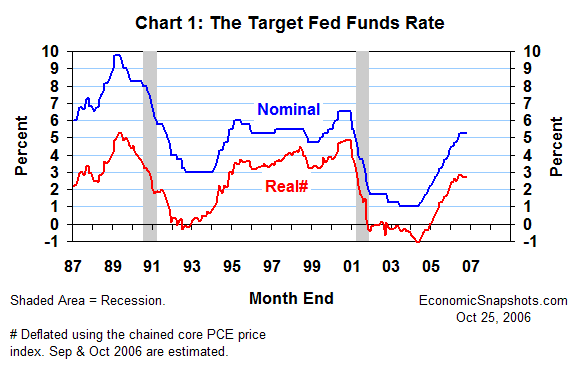
| Back to Index |
October 25, 2006 – The FOMC voted today to leave its Fed funds target unchanged at 5.25%, continuing the “wait and see” strategy first adopted in August (Chart 1). Before August, the FOMC had been in tightening mode, raising its Fed funds target by a total of 425 basis points over a two-year time frame.

Richmond Fed President Lacker voted against today’s policy decision, as he has done since August. Lacker would have preferred to raise the Fed funds target by 25 basis points to 5.5%.
According to the FOMC’s post-meeting policy statement, “Economic growth has slowed over the course of the year, partly reflecting a cooling of the housing market. Going forward, the economy seems likely to expand at a moderate pace.”
Thus, FOMC members remain reasonably confident that this year’s slowdown won’t escalate into a landslide. This suggests, in turn, that they are not seriously considering the possibility of easing U.S. monetary policy, at present.
Instead, the FOMC statement continued to focus on the U.S. economy’s unacceptably high “core” inflation rate (excluding food and energy prices), and the continuing high inflation risk posed by the “high level of resource utilization”. Because of these inflation concerns, the FOMC remains more inclined to tighten than to ease.
For the time being, however, the FOMC majority continues to believe that a slower trend in real demand growth (especially real consumer spending growth) will serve to gradually diffuse these inflation pressures “over time”. But, the FOMC also repeated its warning that either too much demand growth and/or too much inflation might yet prompt further monetary policy tightening.
Bottom line: As long as the economy continues to evolve in line with the FOMC majority’s forecast, the outlook continues to favor a long stretch of unchanged U.S. monetary policy.
Suzanne Rizzo